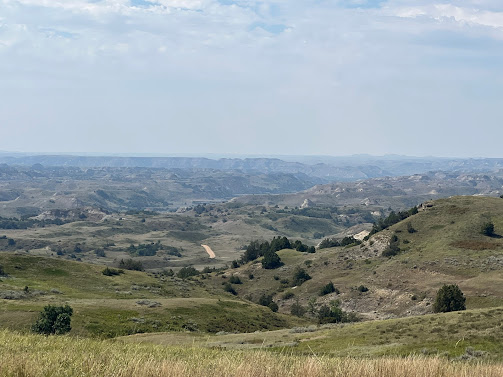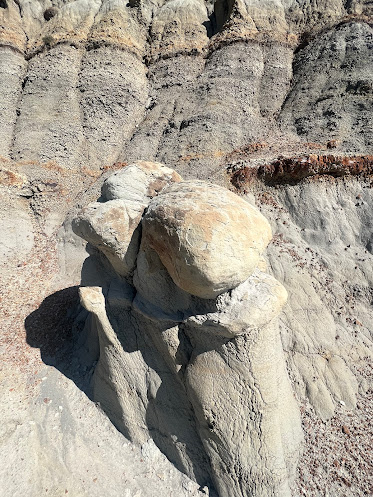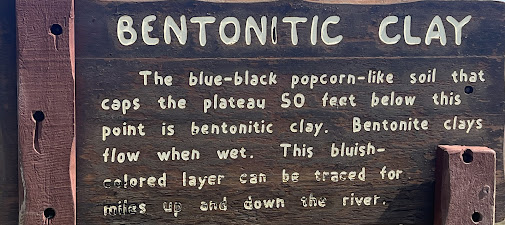North Park Campground Dickinson, ND
Theodore Roosevelt National Park is located in the badlands in western North Dakota comprising
three geographically separated areas. Honoring U.S. President Theodore
Roosevelt, it is the only American national park named directly after a single
person.
The park covers 70,446
acres of land in three sections: the North Unit, the South Unit, and the Elkhorn
Ranch Unit. The Little Missouri River flows through all three
units of the park. The Maah Daah Hey Trail connects all three units.
The park's larger South Unit lies alongside Interstate 94 near Medora,
North Dakota. The smaller North Unit is situated about 80 miles north of the
South Unit, and Roosevelt's Elkhorn Ranch is located between the North and
South units.
Both main units of the
park have scenic drives, approximately 100 miles of foot and horse trails,
wildlife viewing, back country hiking and camping. The park received
850,000 recreational visitors in 2021.
Roosevelt first came to the North Dakota badlands to hunt bison in September 1883. During
that first short trip, he got his bison and fell in love with the rugged
lifestyle and the "perfect freedom" of the West. He invested $14,000
in the Maltese Cross Ranch, which was already being managed by Sylvane Ferris
and Bill Merrifield, seven miles south of Medora. That winter, Ferris and
Merrifield built the Maltese Cross Cabin.
After the death of both his wife and his mother on February 14, 1884, Roosevelt
returned to his North Dakota ranch seeking solitude and time to heal. That
summer, he started his second ranch, the Elkhorn Ranch, 35 miles north of Medora, which he hired two
Maine woodsmen, Bill Sewall and Wilmot Dow, to operate. Roosevelt took great
interest in his ranches and in hunting in the West, detailing his experiences
in pieces published in eastern newspapers and magazines. He wrote three major
works on his life in the West: Ranch Life and the Hunting Trail, Hunting Trips of a Ranchman and The Wilderness Hunter. His adventures in "the strenuous
life" outdoors and the loss of his cattle in the starvation winter in
1886–1887 were influential in his pursuit of conservation policies as President of the United
States (1901–1909).
South Unit
We spotted several buffalo on the way into the South Unit.
We thought these were wild horses inside the park boundary. After talking with the Park Ranger, he corrected and informed us these are feral (untamed) horses. Their genetics carry a gene link from domesticated horses, therefore, they are feral and not wild. Wild horses are an actual breed rather than just denoting they live in the wild. The NPS has started a plan to remove them from the park, but their plan is being fought by local people who want them to remain.
Karma has learned to come and assume his picture position without much prompting.
This was Theodore Roosevelt's cabin/home when he came to North Dakota after losing his wife and Mother on the same day. Their deaths left him despondent. He had to get his life back together so he could start life without them. He found he could do that in the Bad Lands of now North Dakota.
If you look closely, there is a door entry into what we would consider the attic of the cabin. Actually, it is an entry for the cowboys who worked the ranch with Roosevelt. When they were at the cabin, they lived in the attic. This allowed them to access it without disturbing Theodore.
This interesting horse was crafted out of tongue depressors. The clothing and horse tack actually belonged to Theodore Roosevelt.
Lisa found this statue of a cowboy while exploring the quaint town of Medora. We found a place with outdoor seating so Karma could enjoy lunch with us before we toured the South Unit. There was a group of locals performing live music during lunch time in an open patio area across the street as tourists strolled through town. It was truly a sunny, picture perfect day to be outdoors and enjoy our visit. We loved the mild weather and this friendly little town.
The pictures above show a sample of the south side of the mountain range.
The north side of the mountain range is a bit more green and lush.
Karma discovered this petrified wood in the park. The trunk of the tree was laying on the ground. The last picture shows the petrified stump still in the ground. Interestingly, it looks as if it was cut down with a saw.
We saw so many of these prairie dogs along the roadside. You see these little animals everywhere as they pop in and out of their mounds. It is funny how they sit up and look all around.
A mare with and her colt were alongside the road. No fences, just wide, open land for them to roam.
We felt so disappointed when we were unable to capture the colors in the canyons. They were absolutely stunning.
The barrier at the overlook was constructed with pieces of petrified wood. We found it very humorous that today petrified wood is treated as very special, yet 100 years ago because it was so plentiful, it was used as support in the concrete for a guardrail.
North Unit
Lisa, the rock hound, was studying the rocks. I would bet money she has at least a few in her pockets. We literally already have hundreds of rocks, but she keeps bringing them home. She loses all sense of time looking at/working on rocks. Thank goodness, these were pretty plain, unexciting rocks- so this was a quickie.
Cannonball concretions are large, spherical concretions, which resemble cannonballs. These are found along the Cannonball River in North Dakota, and can reach 9.8 ft in diameter. They were created by early cementation of sand and silt by calcite. Similar cannonball concretions, which are as much as 13 to 20 ft in diameter, are found associated with sandstone outcrops of the Frontier Formation in northeast Utah and central Wyoming. They were formed by the early cementation of sand by calcite.
Karma and Lisa were admiring the Cannonballs. Thankfully, these were all too big for her to put in her pocket to bring home.
This cliffside is the result of the winds and the weather conditions in the area over thousands/millions of years. The process is continually in a state of change. The changes are too gradual for us to see much difference during our lifetimes, but change is still slowly occurring.
Lisa encountered yet another snake. A park ranger later identified it as a Prairie Bull snake. He told us he had never seen one before, of course that didn't impress Lisa. Rattlesnakes are very common in the area. She walks in these deserts and other snake infested areas with her head on a swivel looking out for them.
The buffalo were in no particular hurry to get out of the road at North Park. Several people annually get hurt by the buffalo in the park system because of their own stupidity. People try to get close enough to get their picture with one or try to pet it. When you intentionally disturb a buffalo to the point of them attacking, well..... you deserve to be taught a lesson!
This buffalo obviously needed some alone time and was wandering all by himself. The males tend to wander off alone, but the females typically stay with other females and their babies. There is safety in numbers for them.
They believe at some point the loop will cease to exist and the river will straighten itself out. Nature is pretty amazing when humans do not interfere with it.
You can see this petrified log sticking out of the cliff below the overlook. We both had assumed that petrified trees were unique to the national park in Arizona. We were very wrong in our assumptions. Any place where you find petrified wood was previously under water for many, many years.
As long as humans are in control of the rivers via dams and locks to control flooding, it prevents the natural cycle of the tree growth of the cottonwoods. This is resulting in invasive plants taking over.
Theodore Roosevelt National Park is one the few National Parks that is fenced. It was fenced to control the buffalo herd within the park. Currently, the number of buffalo has maxed out the number that the park property can support. The extra buffalo's are moved to other National Parks that are trying to increase their population.
The view from this location has always been considered special. Before its designation as a National Park, this was the view that captured people's hearts and encouraged them to preserve it.
The Texas Longhorn were driven north to create the herds in North Dakota. The National Park maintains a herd of 8 within the park. We found it odd that the NPS wants to maintain the herd of 8 Longhorns, but want the horses completely removed from the park.
Enchanted Highway
The Geese in Flight sculpture was erected in June 2001. It was designated in the Guinness Book of World Records as the largest scrap metal sculpture in
the world. Used oil well
pipe and oil tanks were used to create the piece which weighs over 75
tons. The ray is 156 feet long and 110 feet
tall. The largest goose has a 30 foot
wingspan and is 19 feet tall.
The Deer Family sculpture was completed in 2001 and erected in
2002. It was made from old oil well
tanks cut and welded to form the shadow design.
The buck is 75 feet tall and 60 feet long. The doe is 50 feet tall and 50 feet long.
The
Grasshoppers in the Field sculpture was the fourth site erected and went up in summer of
1999. This was meant to be a reminder of the hardships farmers have overcome while making
their living off the land. The sculpture
was made from old fuel and oil well tanks.
The large grasshopper is 50 feet long and 40 feet tall.
This is a three dimensional sculpture created out of scrap tin to form the seven fish. The fish swimming under the water scene includes a small mouth bass,
walleye, catfish, northern pike, salmon and bluegill. Jumping out of the water is a rainbow trout.
Lisa is scoping out the river rocks that surround the base. She just cannot help but look at rocks wherever we go.
Pheasants
in the Field was completed in 1996. You
cannot bag this three-dimensional pheasant which was made using wire mesh, but you can
admire this piece of art that took 3 years to complete. The rooster stands 40 feet tall and 70 feet long.
The hen is 35 feet tall and 60 feet long.
The chicks are 15 feet tall and 20 feet long.
Teddy Rides Again was erected in 1993 as a tribute to Theodore Roosevelt's role in North Dakota’s
history. The sculpture was created from used
well pipe. Teddy and his favorite horse, Mulley, stand 51 feet tall and weighs over 9000 pounds. It stands just south of
Black Butte which is 3112 feet above sea level.
Tin Family was the first site erected on the Enchanted Highway in 1991. It was built from old, used farm equipment. The sculpture required many hours of labor and welding to achieve this initial creation. The Tin Pa stands 45 feet tall and is held up
by 16 telephone poles. The tin Ma is 44
feet tall while the Son is a mere 23 feet tall.
We stopped in the town of Regent, ND at the gift shop located at the end of the Enchanted Highway. Karma apparently thought this buffalo was a photo op, so he posed with it. He is looking over at Lisa (C'mon mom, I am being a good boy and waiting for you....) because she was not doing her role. We must be getting very predictable when the dog signals us to follow the plan. He has learned the benefits of being a good boy. She bribes him with "good boy treats".
The newest pieces being created are the knight and a fire breathing dragon. This will likely mark the end of the sculptures in the series.

The end of the 32 mile Enchanted Highway is in Regent, ND. It was created by a gentleman who had left town many years ago for work. He retired in his 50's from being a High School Principal. Upon his retirement, he returned to Regent. He discovered the town was shrinking as there were no attractions to lure travelers. He started the Enchanted Highway with it terminating in Regent. He bought the local High School which had been sitting empty since the school closed. He transformed the abandoned school and converted it into the Enchanted Castle. The Enchanted Castle is a hotel, restaurant and bar but it has been closed since the COVID pandemic. Unfortunately, his work appears to be the only attractions added to the area and they have not made a huge impact. There is very little except for old, abandoned buildings which lay in decay as they remain not in use in the town. The gift shop sells ice cream, but there are no other shops or restaurants currently open in the town. The population continues to decrease as the people die off or move looking for work.
Of course, we had to stop for a few scoops of ice cream at the gift shop before we headed back. She let us bring Karma into the store and was pretty smitten by him. She fixed him his own bowl of ice cream. His was free but we had to pay for ours.






















































































































